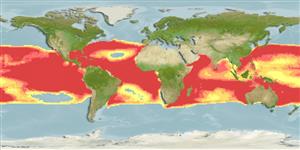Classification / Names
Common names from other countries
Main reference
Size / Weight / Age
Max length : 35.0 cm TL male/unsexed; (Ref. 5217); common length : 25.0 cm TL male/unsexed; (Ref. 5217)
Environment
Marine; pelagic-oceanic; oceanodromous (Ref. 51243); depth range 0 - 20 m
Climate / Range
Tropical, preferred ?; 46°N - 42°S, 180°E - 180°W
Distribution
Widespread in tropical zones of all oceans. Western Atlantic: Massachusetts, USA to southern South America (Ref. 7251). Eastern Atlantic: equator eastward to 8°W, Cape Verde. Northwest Atlantic: Canada (Ref. 5951). Indian Ocean: widely distributed but absent from the Red Sea, northern Arabian Sea, and the Persian Gulf (Ref. 3395). Western Pacific: absent in inland waters of southeast Asia (Ref. 9839). Eastern Central Pacific. The distinction between Cheilopogon antoncichi and Cheilopogon unicolor awaits clarification.
Countries | FAO areas | Ecosystems | Occurrences | Introductions
Short description
Dorsal
spines
(total): 0;
Dorsal
soft rays
(total): 12-14;
Anal
spines: 0;
Anal
soft rays: 9 - 11. Body dark iridescent blue above, silvery white below; pectorals dark grey, with a broad pale margin crossed by a pale stripe becoming narrower toward anterior fin margin; pelvic fins pale (Ref. 2797). Juveniles up to 10-19 cm SL with dark bars on body and variegated paired fins (Ref. 2797).
IUCN Red List Status (Ref. 115185)
Threat to humans
Harmless
Human uses
More information
ReferencesAquacultureAquaculture profileStrainsGeneticsAllele frequenciesHeritabilityDiseasesProcessingMass conversion
Tools
Special reports
Download XML
Internet sources
Estimates of some properties based on models
Phylogenetic diversity index
PD50 = 0.5000 many relatives (e.g. carps) 0.5 - 2.0 few relatives (e.g. lungfishes)
Trophic Level
4.0 ±0.65 se; Based on food items.
Resilience
High, minimum population doubling time less than 15 months (Preliminary K or Fecundity.)
Vulnerability
Low vulnerability (19 of 100)
Price category
